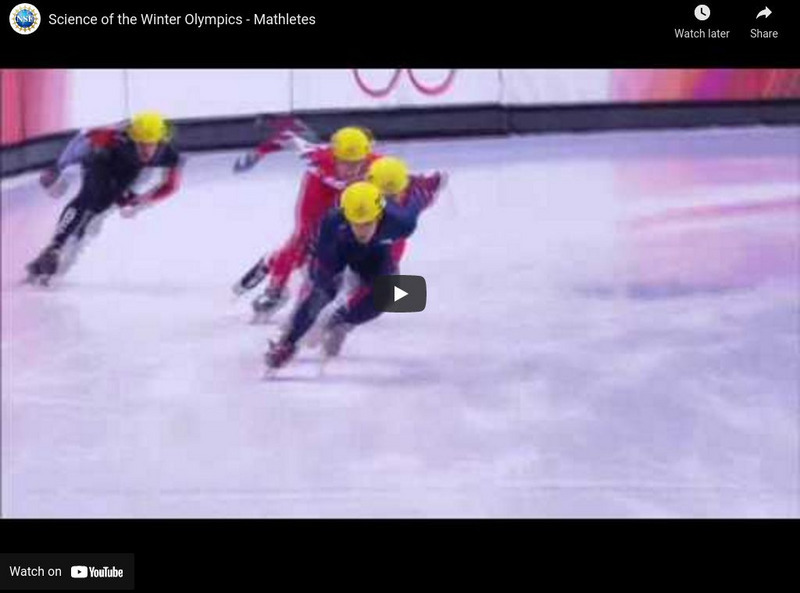National Science Foundation
National Science Foundation: Science of the Winter Olympics: Mathletes
It's been called "the Queen of Sciences" - mathematics. It might not be as obvious in Olympic sports as physics or materials-engineering, but math - from simple arithmetic to calculus - is part of every jump, every spin, every move the...
National Science Foundation
National Science Foundation: Science of the Winter Olympics: Internal Athletes
Cross-country skiers are among the fittest athletes in the world. Deborah King, an associate professor in the Department of Exercise and Sports Sciences at Ithaca College and Joseph Francisco, president of the American Chemical Society,...
National Science Foundation
National Science Foundation: Science of the Winter Olympics: Science Friction
Curling has been in the Winter Olympics for a while now, but it still seems a little strange to most of us. John Shuster, the captain - or "skip" - of the U.S. Curling Team in the Vancouver Winter Olympics, explains this unusual sport,...
National Science Foundation
National Science Foundation: Science of the Winter Olympics: Competition Suits
Olympic athletes have long worn special competition clothing to gain an edge. Science and technology continue to improve on what they wear. Hear from Olympians Chad Hedrick, Steve Holcomb and Erin Hamlin, and Melissa Hines, the director...
NBC
Nbc Learn: Science of the Olympic Winter Games
16 amazing videos exploring the science and mathematics, behind the Winter Olympic games. Be intrigued and the thought, precision, and passion behind the world's greatest sporting events. Sign up for lesson plans and activities.
National Science Foundation
National Science Foundation: Science of the Winter Olympics: Olympic Motion
Dan Fletcher, a bioengineer, studies the movement of cells in the human body. He explains that it is practice that causes muscles to organize themselves for peak performance in an athlete. [5:39]
Science Friday Initiative
Science Friday: Olympic Ski Jump Training in the Wind Tunnel
In this video, we see how U.S. Olympic ski jumpers learn to perfect their aerodynamic technique with the help of a wind tunnel and a physics professor. Aired Feb. 4, 2014. [2:57]
National Science Foundation
National Science Foundation: Science of the Winter Olympic Games: Science of Snow
Snow is an essential part of the Winter Olympics. A former Winter Olympian, who is also a glaciologist, and a chemist discuss how humidity and temperature help form snow. [4:40]
National Science Foundation
National Science Foundation: Science of the Winter Olympics: Downhill Science
Scientists explain the physics of the downhill skiing event at the Winter Olympics. [3:59]
National Science Foundation
National Science Foundation: Science of the Winter Olympics: Aerial Physics
Freestyle skiers use three basic twisting techniques to perform complex jumps in the air. These aerial maneuvers can be explained in terms of physics concepts. [4:00]
National Science Foundation
National Science Foundation: Science of the Winter Olympic Games: Physics of Slope Style Skiing
A scientist explains the physics of slope-style skiing, e.g., rotational motion, moment of inertia, angle of momentum, and friction. [4:58]
National Science Foundation
National Science Foundation: Science of the Winter Olympics: Banking on Speed
The American bobsled team, scientists, and a bobsled designer explain how they hope to win a gold medal at the Vancouver Winter Olympics in 2010. [5:05]
National Science Foundation
National Science Foundation: Science of the Winter Olympics: Competition Suits
Winter Olympic athletes and scientists discuss the science and technology behind the clothing the athletes wear in competition. [5:12]
National Science Foundation
National Science Foundation: Science of the Winter Olympic Games: Injury and Recovery
Biomedical engineer Cato Laurencin describes his pioneering work in tissue regeneration. His research looks at helping high performance athletes such as alpine ski racer Lindsey Vonn to recover faster from ligament damage in a knee...
National Science Foundation
National Science Foundation: Science of the Winter Olympic Games: Shaun White Engineering the Half Pipe
A mechanical engineer explains how the half-pipe is designed to give an Olympic snowboarder maximum air time so he can perform tricks. [5:22]
National Science Foundation
National Science Foundation: Science of the Winter Olympic Games: Building Faster and Safer Bobsleds
Scientists explain the design challenges faced when making bobsleds that are fast and safe. [6:10]







